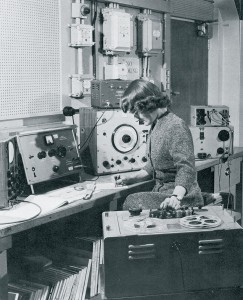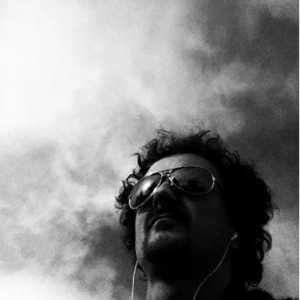 Photo via: http://www.soundonsound.com/sos/feb09/articles/oramics.htm
Photo via: http://www.soundonsound.com/sos/feb09/articles/oramics.htm
When I first came here I was expecting to find beautiful chromium-plated equipment and everyone wearing white coats and in fact I found the tattiest studio all full of virtually redundant antique equipment.
~ Daphne Oram
We have also sound houses, where we practice and demonstrate all sounds and their generation. We have harmonies which you have not, of quarter sounds and lesser slides of sounds. Divers instruments of music likewise to you unknown, some sweeter than any you have; together with bells and rings that are dainty and sweet. We represent small sounds as great and deep; likewise divers trembling and warblings of sounds, which in their original are entire. We represent and imitate all articulate sounds and letters, and the voices of beasts and birds. We have certain helps which set to the ear to do further the hearing greatly. We have also divers strange and artificial echoes, reflecting the voice many times, and as if it were tossing it; and some that give back the voice louder than it came, some shriller and some deeper; yea, some rendering the voice, differing in the letters or articulate sound from that they receive. We have also means to convey sounds in tubes and pipes, in strange lines and distances…
~ Francis Bacon, The New Atlantic
Wee Have Also Sound Houses [MP3]
[audio:https://dl.dropboxusercontent.com/u/2251996/Wee_Have_Also_Sound_Houses.mp3]
BBC radio documentary from 1983 exploring the life and legacy of Daphne Oram – pioneer of electronic music and inventor of the optical synth.
Oramics Machine, Daphne Oram, BBC Click Jan 8, 2012 [Mp4]
“This programme is an experiment. An exploration. It’s been put together with enormous enthusiasm and equipment designed for other purposes. The basis of it is an unlimited supply of magnetic tape, recording machine, razor blade, and some thing to stick the bits together with. And a group of technicians who think that nothing is too much trouble – provided that it works.
“You take a sound. Any sound. Record it and then change its nature by a multiplicity of operations. Record it at different speeds. Play it backwards. Add it to itself over and over again. You adjust filters, echos, acoustic qualities. You combine segments of magnetic tape. By these means and many others you can create sounds which no one has ever heard before. Sounds which have indefinable and unique qualities of their own. A vast and subtle symphony can be composed from the noise of a pin dropping. In fact one of the most vibrant and elemental sounding noises in tonight’s programme started life as an extremely tinny cowbell.
“It’s a sort of modern magic. Many of you may be familiar with it. They’ve been exploiting it on the continent for years. But strangely enough we’ve held aloof. Partly from distrust. Is it simply a new toy? Partly through complacency. Ignorance too. We’re saying at last that we think there’s some thing in it. But we aren’t calling it ‘musique concrète’. In fact we’ve decided not to use the word music at all. Some musicians believe that it can become an art form itself. Others are sceptical. That’s not our immediate concern. We’re interested in its application to radio writing – dramatic or poetic – adding a new dimension. A form that is essentially radio.
‘Properly used, radiophonic effects have no relationship with any existing sound. They’re free of irrelevent associations. They have an emotional life of their own. And they could be a new and invaluable strand in the texture of radio and theatre and cinema and television.’
Private Dreams and Public Nightmares (1957) [Mp3]
[audio:https://dl.dropboxusercontent.com/u/2251996/Private_Dreams_and_Public_Nightmares_1957.mp3]
An early BBC experiment in radiophonic sound, predating the establishment of the Radiophonic Workshop.

